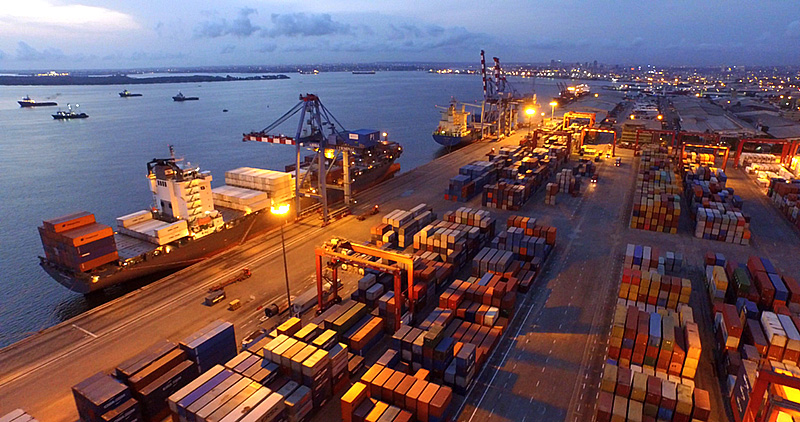West African ports are vital to the region’s ambitions to emerge as a global energy hub. In this strategic pursuit, international heavyweights such as China and the UAE have stepped forward as key investors, leveraging their influence in the region while bolstering the competitiveness of West African ports. This surge in investment is fueling a drive towards modernization, with several West African nations positioning themselves as logistics and energy hubs, anchored by significant port transformations.
West African ports – Investment and transformation
As the West African logistics landscape evolves, several prominent ports have undergone significant transformations, ushering in a new era of economic growth and connectivity for the region.
Port of Lomé, Togo
Situated on the Gulf of Guinea, the Port of Lomé in Togo has emerged as a pivotal deep-water port serving as a transshipment centre for West Africa. With strategic geographic placement, it provides vital access to landlocked nations, including Mali, Niger, Burkina Faso, and northern Nigeria. Covering over 900 hectares, the port stands as an international trading hub, boasting a substantial industrial free zone that attracts numerous companies. Key factors contributing to its allure include high-quality port infrastructure and favorable regulations. Terminal Investment Limited secured a 35-year concession from the Togolese government to build and operate a container terminal within the port. Remarkably, the Port of Lomé has witnessed a remarkable growth trajectory, elevating cargo volumes from 300,000 twenty-foot equivalent units (TEU) in 2013 to a staggering 2.2 million TEUs in 2022, rapidly claiming the title of West Africa’s busiest port.
Port of Abidjan, Ivory Coast
In 2022, Ivory Coast Terminal, a subsidiary of Bolloré Transport and Logistics and APM Terminals, inaugurated the second container terminal at the Port of Abidjan. This ambitious project has transformed Abidjan into one of West Africa’s largest and most advanced harbors, boasting an annual capacity of 2.5 million TEUs. The port now features three container berths, a Ro-Ro berth, and a general cargo terminal. This substantial enhancement has already significantly bolstered Ivory Coast’s economy, with the port contributing over 50% of the country’s annual GDP. Serving as a critical link for landlocked nations such as Mali, Niger, Chad, and Burkina Faso, the Port of Abidjan plays an indispensable role in regional trade.
Port of Tema, Ghana
Ghana’s largest port, the Port of Tema, received a substantial boost in 2015 through a joint venture between French corporation Bolloré and APM Terminals, raising an impressive USD 1.5 billion in investment. This infusion of capital enabled the Port of Tema to accommodate next-generation vessels, making it a hub for diverse maritime activities. With an average of 1,511 vessel calls annually, including container ships, general cargo vessels, tankers, Ro-Ro, and cruise vessels, the port processed an impressive 1.2 million TEUs of containers in 2022. Located in the bustling industrial city of Tema, the port complex serves as a logistical nerve center for various enterprises, including the mining sector.
Lekki Port, Nigeria
April 2023 marked a significant milestone with the commencement of commercial operations at the Lekki deepwater seaport in Nigeria. As the nation’s largest port, Lekki was purposefully designed to accommodate vessels with capacities exceeding 18,000 TEUs, alleviating congestion at the overcrowded Apapa and Tincan ports. Additionally, it is poised to serve as a transshipment center for West Africa’s thriving oil and gas industry. Prior to its completion, much of Nigeria’s import volume was directed to ports in neighboring countries, such as Cotonou in Benin and Lomé in Togo.
Ndayane Port, Senegal
In early 2022, President Macky Sall inaugurated the first phase of the Ndayane port, located approximately 80 km south of Dakar, Senegal. Spearheaded by Dubai Port World, this monumental project boasts an annual capacity of 1 million TEUs, making it the largest multipurpose port in West Africa. The initial phase, with an estimated cost of USD 827 million, encompasses a 300-hectare container terminal, a 5-km shipping channel, and an 840-meter quay with an 18-meter draft. Over the next four years, the port aspires to emulate the success of Jebel Ali, the Persian Gulf’s pioneering deepwater port. Notably, this endeavor represents Senegal’s most substantial private investment to date.
With substantial investments and ambitious port modernization projects, global partners and West African nations are forging a path toward enhanced connectivity, economic growth, and regional influence.
For more trade news, visit our dedicated portals.
